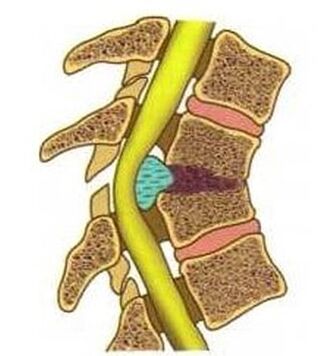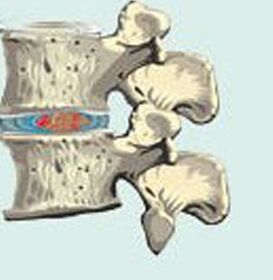Osteochondrosis is a degenerative-district spinal disease, in which the lesion of the intervertebral discs is observed in the form of their deformation, reduction of height and stratification. The manifestations of this pathology are varied, but they can be combined in some syndromes. Depending on the severity of the symptoms, the changes in the intervertebral discs that surround their structures are distinguished, some stages of osteochondrosis are distinguished. Before treating the osteochondrosis of the cervical region, it is important to find out why various medicines, physiotherapeutic and surgical methods are needed.

General information
Cervical back osteochondrosis most often develops in people over 35, but sometimes its manifestations are observed at the age of 18-30. The cervical spine consists of beads, the most mobile of them is usually affected-5, 6, 7.
Among the vertebrae are intervertebral discs, which are a special form of the most durable bone of cartilage bone. They provide the ability of the spinal column to withstand important loads and its mobility.
The intervertebral disk disk consists of:
The intervertebral discs are connected to the vertebrae bodies using a ligamental apparatus.
Causes of osteochondrosis
In people over 20, ships that feed intervertebral discs are overloaded. In the future, these structures receive all the necessary substances from diffusion from a number of arranged vertebrae, but often these processes are not sufficient for normal metabolism on the disc.
Osteochondrosis of the cervical spine most often develops under the influence of:
These factors exacerbate the violated feeding of the intervertebral discs. As a result, the chicken core is flattened, they become less elastic. The load on fibrous rings increases, which is associated with their extension, the formation of cracks in them.
Despite the backdrop of such degenerative changes, the intervertebral disc can last towards the spinal canal. Irritation of the posterior longitudinal ligament rich in nerve endings is associated with local pain.

With the progression of the disease, a rupture of the posterior longitudinal ligament occurs, the intervertebral disc is prolonged in the cerebrospinal canal, this condition is called hernia. At the same time, turkeys syndrome is developing, caused by irritation of the cerebrospinal spine, local autoimmune inflammation. If the radicular-spinae artery is squeezed, the blood supply to the spinal cord is concerned.
The cervical spine osteochondrosis is associated with the formation of osteophytes - results from bone tissue in bodies, vertebra processes. These formations can also squeeze the roots of the spinal nerves or spinal cord.
First signs
Osteochondrosis of the cervical-toracal department in the initial phase is associated with tension, rapid fatigue of the muscles of this area. Subsequently, discomfort, pain in the NAP, neck, shoulder, intensifying during the tendencies, joins the head curves.
Dizziness, headache - another first sign of cervical osteochondrosis in women, men. Sometimes a person experiences pain, a feeling of numbness, being punished in his hands after a night's sleep.
The main symptoms
The cervical spine osteochondrosis is most often characterized by:
Some people have dystrophic syndromes of reflex, discogenic cervical myelopathy. Disordishes in the emotional sphere, panic attacks with cervical osteochondrosis are often often marked.
Novice syndrome
Manifestations of radicular syndrome are caused by the compression of the spinal nerves of the hernia of the intervertebral discs, osteophytes of the bodies, processes of the vertebra itself. As a result of compression of the nerve fibers, a local inflammatory reaction develops, which is associated with pain through the cooling of the affected nerve.

Therefore, with cervical osteochondrosis, symptoms such as neck pain, hands, spine areas occur. Unpleasant sensations can be marked in the heart, stomach. If the neck pain remains constantly, intensifies when it turns, the slope of the head, this condition is called the cervix. Also, the pain can have the character of lumbago, give in hand, they are called Servicio.
In those areas that innovates the affected nerve, there is a significant decrease in sensitivity. The muscles in this area become weaker, their atrophy can be observed, which is associated with a decrease in their volume.
Vail artery syndrome
Vertebral artery is a paired blood vessel that provides blood supply to the brain by 15-30%. When squeezing vertebral arteries, various chronic manifestations of oxygen insufficiency in the central nervous system are marked by changed intervertebral discs, growth of vertebrae.
In the development of this condition, 2 stages are distinguished: functional, organic (ischemic). In their first, the main symptoms of vertebral artery syndrome with cervical osteochondrosis are frequent headaches. They become more pronounced in head movements as well as holding a position for a long time. The pains are aches or pulsating, felt in occipital, temporary, frontal areas.
Dizziness for cervical osteochondrosis is also characteristic of the functional phase of this syndrome. Its intensity is different: from a feeling of instability to a feeling of sudden falling or rapid body rotation. Sometimes hearing is reduced, a person may be disturbed by noise in the ears. Disordishes visual disorders are marked in the form of flies, lighting in front of their eyes.
As the pathology progresses, the ischemic phase occurs. It is characterized by temporary disorders of cerebral circulation in the form of transient ischemic attacks, the appearance of which is often provoked by a rapid slope or turning the head.
There are some options for vertebral artery syndrome, with cervical osteochondrosis, whose manifestations have their own characteristics:
With a falling attack, a person suddenly falls, throws his head, cannot move. Losses of consciousness have not been observed, the ability to move independently after a few minutes. This condition is caused by insufficient blood flow to the brain, brain luggage.
Cervical migraine syndrome occurs due to compression of alternating interpretations or osteophytes of nerve plexus surrounding vertebral arteries. This condition is characterized by stupid headaches, which periodically become pulsating. They usually arise if you have to maintain a forced head position for a long time, for example, this often occurs after sleeping on an unpleasant pillow when working on the computer. Such headaches for osteochondrosis of the cervical region become stronger during the origin, climbing the stairs, trembling while driving, fast walking. The pains are located on one side in the occipital region, applied to the front of the head. They can continue from a few minutes to hour.

Manifestations of vertebral syndrome Sincopa occur due to insufficient intake of oxygen in reticular brain formation. This condition is accompanied by a short -term pallor, with a long standing of the head, neck in a forced position.
Symptoms of cervical osteochondrosis in women, men in the form of pain, feeling of sand in the eyes, sparks in front of them are some of the manifestations of an ophthalmic syndrome. There is a decrease in visual acuity, which is more pronounced with increased load on the eye, a partial loss of vision fields is possible. Closing occurs, conjunctiva rash is visible.
Basic migraine attack begins with a decrease in vision of both eyes, noise in the ear, damaged walking, lubrication of speech. We also notice dizziness with osteochondrosis of the cervical of this course variant. Then there is a severe headache in the occipital region, accompanied by vomiting, the attack ends with a loss of consciousness.
With the development of a cochleo-investing syndrome, when involving the pathological process of vertebral artery in the ears, a person marks a hearing decrease, and a perception of the word whisper is especially difficult. Feeling your body's instability in space, a feeling of rotation of nearby objects.
Vegetative dysfunction syndrome reflects disorders in the work of the autonomic nervous system in response to squeezing vertebral artery, nerve fibers located around it. It is characterized by a feeling of heat, tremors, increased sweating. The legs, palms become cold, wet by touch and pain stitched in the heart. Vegetative symptoms of cervical osteochondrosis in men, women usually accompany the manifestations of other syndromes.
Ischemic transer attacks are suddenly attacks of damaged coordination of movements, severe dizziness, damage to speech, nausea and vomiting. If a person takes a horizontal position, these manifestations usually decrease. After such an attack, a headache, weakness, flies, stares in front of the eyes, noise in the ear has been stored for some time.
Sometimes there is an increase in blood pressure with cervical osteochondrosis, which is also a consequence of squeezing the vertebral artery. As a result, the area of the brain, which is responsible for regulating pressure, has no oxygen. The same nerve impulses arise in it as lowering blood pressure, under whose influence it increases significantly.
Stages of development of osteochondrosis
As degenerative-district changes develop in the intervertebral discs, osteochondrosis in its development exceeds several stages.
Osteochondrosis of the 1st degree of cervical region (pre -clinical phase)
Osteochondrosis of the cervical-corecic department at this stage is associated with muscle tension, discomfort. There is a slight softness of the cervical lordosis (physiological curvature of the spine in the shape of its bulb in front). Sometimes the pain appears in the area, a temporary decrease in the collar area is possible.
Osteochondrosis 2 degrees
There is a feeling of weakness in the hands, numbness of the skin of the face, neck, also reduces sensitivity to the upper limbs. Vision deteriorates, noise in the ears is marked.
Osteochondrosis 3 degrees
At this stage, there is a rupture of the intervertebral disc with or without its formation. Neck pain, the collar area becomes more pronounced, permanent, is given in their hands.

Osteochondrosis 4 degrees
With osteochondrosis of the cervical spine, not only intervertebral discs, beads, but also nerve fibers, blood vessels are involved in the pathological process, sometimes affected spinal, muscles, joints of the upper half. Symptoms of the disease are different, resembling signs of other pathological conditions. If manifestations of osteochondrosis appear, you should consult a doctor immediately in order to undergo an examination.
First aid for severe pain
Treatment of cervical spine osteochondrosis in case of severe pain should first aim at stopping them. For this, medicines with sedatives are used. They are taken inside, to achieve a faster effect with cervical osteochondrosis, injections of the solutions of these medications are recommended.
Sometimes a piece of pepper is used, this tool irritates skin receptors, improves blood circulation in the area of use. As a result of such an attractive action, experienced pains look less pronounced.
Physiotherapy
Treatment of cervical osteochondrosis in women, men with physiotherapy is intended:
The massage begins with the hit of the collar area in the direction from the spine to the supraklavicular, axillary in areas. Then the squeezes are performed, for this massage puts the hand with a skirt perpendicular to the spine, moves it from top to bottom. In the future, friction is used to improve the muscles, to improve local blood flow. Fingers are performed with straight, circular movements, starting from the base of the skull. Then, in a circular motion, the muscles are cooked in the Jaka area area. To complete the massage, vibrational movements in the form of shocks as well as shocks are used.



















